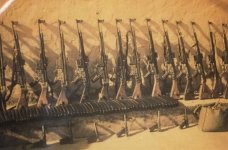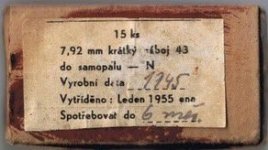You are using an out of date browser. It may not display this or other websites correctly.
You should upgrade or use an alternative browser.
You should upgrade or use an alternative browser.
The Syrian StG44 Cache - 5,000 Mint WW2 Rifles Found!
- Thread starter Gatehouse
- Start date
Yes, they are from the 2012 discovery.
Those Syrian dummies (like Felton said) should have sold them off as parts kits etc., and they would have a lot more $$ for their revolution.
Too bad they joined Al- Queda.
Those Syrian dummies (like Felton said) should have sold them off as parts kits etc., and they would have a lot more $$ for their revolution.
Too bad they joined Al- Queda.
BattleRife
CGN Ultra frequent flyer
- Location
- of No Fixed Address
This was one of the few Mark Felton videos I did not like. There is no new information, no in-depth research. It's just a re-hash of an old news stories, along with some speculation of where they might have come from, and where they might be now.
I read this online, no idea if it's made up or real;


A row of StG-44 assault rifles captured by the French Foreign Legion in Algeria in 1960-1961).
Contrary to some more romanticized accounts, the Algerians did not discover long-lost caches from Rommel’s WWII Afrika Korps, as no StG-44 had ever served in any German unit in Africa during the war. Rather, these guns had arrived to Algeria via Czechoslovakia. When WWII ended in 1945, the Soviet army retained and stored every StG-44 it found.
By best estimate, in 1948 there were about 102,000 StG-44s in Soviet custody. As the SKS and AK-47 were already entering Soviet use, the captured StG-44s were not issued to Soviet units but rather made available for transfer abroad, with Czechoslovakia being the first and main recipient, followed by East Germany.
Hungary also received a small (about 4,000) batch, and Yugoslavia also received some prior to it’s split with the east bloc. These joined StG-44s captured by the Yugoslavs themselves.
Finally the Soviets transferred a few to North Vietnam; these in turn were joined by more transferred from Czechoslovakia and East Germany (which themselves had come from the USSR) as those two countries phased the type out.
The Czechoslovakian army began using the StG-44 in 1946 and by 1949, it was one of the country’s main battle rifles. In 1950 it began to be phased out to storage or passed to other users (primarily East Germany and North Vietnam). It was gone from frontline Czechoslovakian service by 1955 however several thousand still were in storage.
Czechoslovakia was also the main nexus for Kurz ammunition after WWII. Czechoslovakia itself had secured a decent supply inside it’s borders when WWII ended in May 1945. Beginning in 1946 and running for about ten years,
Czechoslovakia was also used by the Soviets to repackage German-manufactured, WWII-vintage Kurz rounds which had been captured by the Soviet army in quantity sizes ranging from factory truckloads to 900-round crates to individual loose rounds. Finally, Czechoslovakia manufactured new-production Kurz rounds, both for it’s own use and to an East German contract.


A row of StG-44 assault rifles captured by the French Foreign Legion in Algeria in 1960-1961).
Contrary to some more romanticized accounts, the Algerians did not discover long-lost caches from Rommel’s WWII Afrika Korps, as no StG-44 had ever served in any German unit in Africa during the war. Rather, these guns had arrived to Algeria via Czechoslovakia. When WWII ended in 1945, the Soviet army retained and stored every StG-44 it found.
By best estimate, in 1948 there were about 102,000 StG-44s in Soviet custody. As the SKS and AK-47 were already entering Soviet use, the captured StG-44s were not issued to Soviet units but rather made available for transfer abroad, with Czechoslovakia being the first and main recipient, followed by East Germany.
Hungary also received a small (about 4,000) batch, and Yugoslavia also received some prior to it’s split with the east bloc. These joined StG-44s captured by the Yugoslavs themselves.
Finally the Soviets transferred a few to North Vietnam; these in turn were joined by more transferred from Czechoslovakia and East Germany (which themselves had come from the USSR) as those two countries phased the type out.
The Czechoslovakian army began using the StG-44 in 1946 and by 1949, it was one of the country’s main battle rifles. In 1950 it began to be phased out to storage or passed to other users (primarily East Germany and North Vietnam). It was gone from frontline Czechoslovakian service by 1955 however several thousand still were in storage.
Czechoslovakia was also the main nexus for Kurz ammunition after WWII. Czechoslovakia itself had secured a decent supply inside it’s borders when WWII ended in May 1945. Beginning in 1946 and running for about ten years,
Czechoslovakia was also used by the Soviets to repackage German-manufactured, WWII-vintage Kurz rounds which had been captured by the Soviet army in quantity sizes ranging from factory truckloads to 900-round crates to individual loose rounds. Finally, Czechoslovakia manufactured new-production Kurz rounds, both for it’s own use and to an East German contract.
Most Felton videos are just that. He’s a known plageristThis was one of the few Mark Felton videos I did not like. There is no new information, no in-depth research. It's just a re-hash of an old news stories, along with some speculation of where they might have come from, and where they might be now.
The Syrians used German K-98 rifles quite a bit.I believe that some of these were imported here. When I was on the Golan Heights in 1979 they had a German PzKwIV dug in as a starionary pillbox. Same with Russian T-34 tanks.
I also read many years ago, so my memory may be off ,but the Syrian army was trained by a cadre of ww2 german officers and nco's right after the war.The Syrians used German K-98 rifles quite a bit.I believe that some of these were imported here. When I was on the Golan Heights in 1979 they had a German PzKwIV dug in as a starionary pillbox. Same with Russian T-34 tanks.






































































